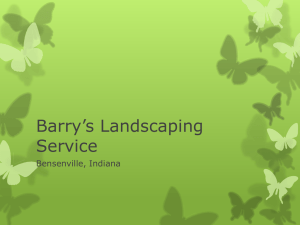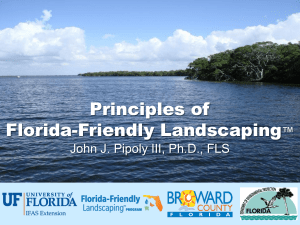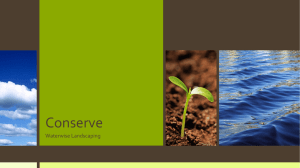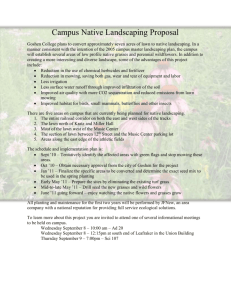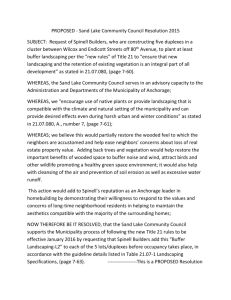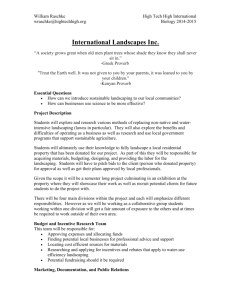Florida Yards & Neighborhoods - CLU-IN
advertisement
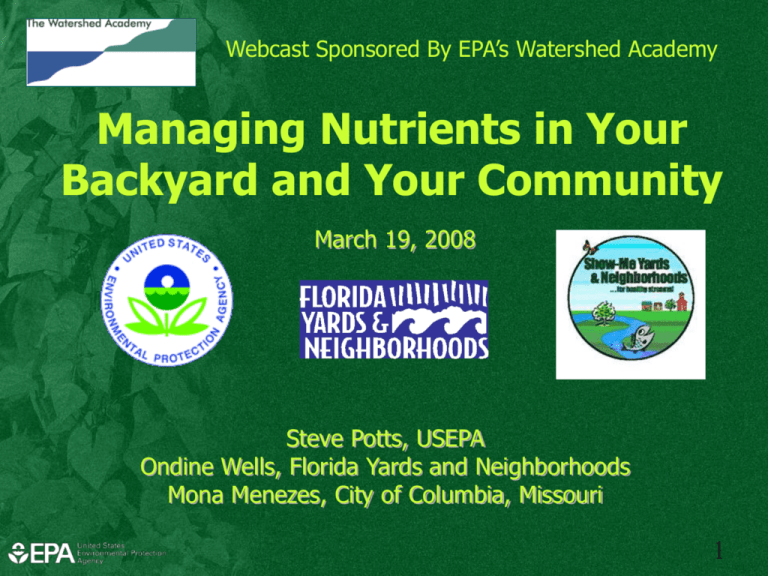
Webcast Sponsored By EPA’s Watershed Academy Managing Nutrients in Your Backyard and Your Community March 19, 2008 Steve Potts, USEPA Ondine Wells, Florida Yards and Neighborhoods Mona Menezes, City of Columbia, Missouri 1 Topics for Today’s Webcast • Nutrient Impacts in Your Watershed • Florida-Friendly Landscaping • Show-Me Yards and Neighborhoods 2 Nutrient Pollution in Your Watershed: What It Is, and Steps To Reduce It Presented by Steve Potts, U.S. EPA Office of Water Office of Science and Technology 3 “Nutrient Pollution” also known as Nitrogen and Phosphorus Pollution 4 Watershed • A watershed is an area of land where all of the water drains into a common body of water. Watersheds are also referred to as “drainage basins.” 5 The path water takes as it flows downhill impacts water quality. Developed Area Water runs off the land, carrying fertilizer, dirt, pet waste and many other pollutants with it directly into the waterway. 6 The path water takes as it flows downhill impacts water quality. Undeveloped Area Water percolates through the ground slowly. 7 Nitrogen and Phosphorus 101 8 What are Nutrients? • Nutrients are elements, like nitrogen and phosphorus, that occur naturally in water, soil, and air • Sources of nutrients Decaying plant matter Animal and human wastes (pet waste, septic tanks, Waste Water Treatment Plants) Detergents Fertilizer (residential, commercial, and agricultural) 9 Nitrogen • Highly soluble in its common compound form, nitrate. • Easily washed from the soil by rain or irrigation. • Leached from the soil or absorbed by plants within weeks of application. • Stimulates shoot growth in plants. • Signs of deficiency can mimic other plant illnesses; yellowing leaves (with or without a reduction in size). 10 Nitrogen – How it Works Most plants are able to absorb nitrogen when it is in an ammonium or nitrate form 11 Phosphorus • Typically found in soil as an insoluble compound. • Leaches from the soil very slowly. • Deficiency appears first as slowed growth. The leaves will become dull and dark green or grayish green. 12 Phosphorus – How it Works Plants absorb the inorganic form of phosphorus 13 Eutrophication: The process of excess nutrients (nitrogen and phosphorus) accelerating the growth of algae in a waterway, which often results in a decrease of oxygen in the waterbody. 14 Nutrient Pollution Is a Serious Problem Top 5 Causes • Waterbodies in almost of U.S. Waterbody every state and territory are impacted by nutrient pollution. • States have identified over 10,000 waterbody segments impaired by nutrients. http://www.epa.gov/waters/305b Impairments 1. Mercury 2. Pathogens 3. Sediment 4. Metals 5. Nutrients 15 Nutrients that Enter Our Waters Come from a Variety of Sources And More! 16 Kinnickinnic River, Wisconsin 17 Sarasota, Florida Note: Data taken from Sarasota Bay Estuary Program. “State of the Bay 2006” 18 The Chesapeake Bay Note: Data take from the Chesapeake Bay Program www.chesapeakebay.net 19 Chesapeake Bay - Phosphorus 20 Soil Erosion Also Carries Nutrients to Waterways Erosion not only washes away valuable soil but carries pollutants, including phosphorus, into waterways. 21 The Chesapeake Bay – Sediment 22 Summary Nutrients and sediment reach waterway Too much fertilizer is applied Algal blooms and other water quality problems result 23 The Clean Water Act & You Clean Water Act (The Law) EPA administers the Clean Water Act (Federal Level) States create, enforce and monitor clean water regulations and report data to EPA Visit www.epa.gov/epahome/state.htm to find your state environmental agency Stakeholder participation in the development of water quality criteria and standards (That’s You!) 24 What are Water Quality Criteria and Standards? • • The foundation of the water quality-based control program mandated by the Clean Water Act. Define the goals for a waterbody by: designating its “uses” setting criteria to protect those uses establishing provisions to protect water quality from pollutants. • For further information see: http://www.epa.gov/waterscience/standards/about 25 Ecological Complexities Create Significant Challenges for Developing WQ Criteria • Linkages among interacting variables: DO Nutrients Light Flow Temperature Substrate Water Chemistry Herbivory Competition Plant/Algal Growth Microbial Growth Aquatic Life pH Habitat Food Recreation Drinking Water Pathogens 26 What is EPA Currently Doing? • Providing States/Tribes and Territories with statistical and expert scientific assistance to identify the complex relationships between nutrients and biological responses depicted in the last slide. Understanding these relationships are critical for developing Water Quality Criteria and Standards. Most States currently working on criteria for rivers/streams and lakes/ reservoirs. • Building a scientific basis for development of nutrient crtiteria for estuaries and wetlands. • Developing outreach materials, such as this webcast, to raise public awareness. • Developing a Progress Report – to be published in May. 27 What Can You do About Nutrient Pollution? It’s simple! Follow these tips: 1. Get Involved in Your States Water Quality Standards Development Process 2. 3. 4. 5. 6. 7. 8. 9. Consider Stream Restoration Projects Test Your Soil Apply Fertilizer Sparingly Adopt Sustainable Lawn Care Practices Improve Drainage Use Water Wisely Plant Natives Plant Lawn Alternatives 28 Get Involved in Your State’s Water Quality Standards! • Visit EPA’s Surf Your Watershed Website http://cfpub.epa.gov/surf/locate/index.cfm Once you locate your watershed, click on Citizen-based Groups in Your Watershed to learn about local ways that you can get involved in water monitoring and other watershed-related activities. 29 Get Involved in Your State’s Water Quality Standards • Participate in the public review process of your state’s water quality standards http://www.epa.gov/waterscience/standards 30 Questions? Steve Potts, Acting Nitrogen and Phosphorus Pollution Criteria Team Leader, U.S. EPA’s Office of Water 31 Protecting Water Resources with Florida-Friendly Landscaping Ondine Wells Statewide Builder and Developer Coordinator Florida Yards & Neighborhoods Program March 19, 2008 32 Presentation Outline Water challenges in Florida Florida Yards & Neighborhoods Educational resources Case Studies Florida-Friendly Landscaping | 33 Growth Indicators Florida Population: • 1980 • 2005 • 2030 ~10,000,000 ~17,000,000 ~28,000,000 Building Permits (Florida): • 2002 ~127,000 • 2003 ~155,000 • 2004 ~185,000 • 2005 ~204,000 www.buildgreen.ufl.edu Florida-Friendly Landscaping | 34 Impacts of Landscaping 25 to 60% of homeowner water use is for lawn & landscape irrigation Nutrient runoff can degrade water bodies + = Florida-Friendly Landscaping | 35 Florida Yards & Neighborhoods (FYN) FYN, a University of Florida Extension program, partners with national, state and local agencies to teach Florida friendly landscaping. Florida-Friendly Landscaping | 36 Florida-Friendly Landscaping Goals Reduce Water Consumption Protect Water Quality Design for Both Humans and Wildlife Florida-Friendly Landscaping | 37 Florida Yards & Neighborhoods (FYN) Audiences Homeowners Homeowner associations Builders and developers Landscape architects Landscape maintenance professionals Landscape and irrigation contractors Real estate professionals Florida-Friendly Landscaping | 38 Florida-Friendly Nine Principles 1. Right plant, right place 2. Water efficiently 3. Fertilize appropriately 4. Mulch 5. Attract wildlife Florida-Friendly Landscaping | 39 Florida-Friendly Nine Principles (cont’d) 6. Manage yard pests responsibly 7. Reduce stormwater runoff 8. Recycle 9. Protect the waterfront Florida-Friendly Landscaping | 40 Low Impact Development Swales Florida-Friendly Landscaping | 41 Low Impact Development Pennsylvania Stormwater Management Manual 2004 Credit: Dr. Mark Clark, UF Florida-Friendly Landscaping | 42 Resources for Homeowners Handbook Consultations Workshops Soil Analysis (provided by Extension offices) Florida-Friendly Landscaping | 43 Resources for Homeowners www.FloridaYards.org Florida-Friendly Landscaping | 44 Resources for Green Industry Professionals Green Industries BMP training Landscape Architect CEU training Florida-Friendly Landscaping | 45 Resources for Developers & Engineers Landscape and Irrigation Design Plan Review Awards Certifications Florida-Friendly Landscaping | 46 Resources for Developers & Engineers Low Impact Development CEU training (provided by UF’s Program for Resource Efficient Communities) Model Covenants, Conditions and Restrictions (CCRs) Florida-Friendly Landscaping | 47 Resources for Governments Model FloridaFriendly Ordinance (developed by FL DEP) Links to city and county ordinances throughout state http://fyn.ifas.ufl.edu/government.htm Florida-Friendly Landscaping | 48 Resources for Governments Low Impact Development training (provided by UF’s Program for Resource Efficient Communities) Florida Irrigation & Florida-Friendly Design Standards (developed by statewide Committee on Landscape Irrigation and Florida-Friendly Design Standards) Florida-Friendly Landscaping | 49 Ongoing Research Irrigation efficiency (soil moisture sensors, ET controllers) Water needs for landscape establishment Turfgrass nutrient leaching Low Impact Development And much more… Florida-Friendly Landscaping | 50 Case Study: Madera Community Location: Gainesville, FL Size: 44 acres Homes: 88 single-family Developer: GreenTrust, LLC Partnership with UF/PREC Narrow Uncurbed Roads Careful & Limited Clearing Florida-Friendly Landscaping | 51 Madera: Model Home Landscape Design Preserved Vegetation Turf Rain Garden MODEL HOME Turf Infiltration Tank Guest Parking Driveway Image Courtesy: Glenn Acomb Associates, Inc Florida-Friendly Landscaping | 52 Madera: Model Home Design Techniques Shared Driveway Limited Impervious Cover Turf Area = 35% Conventional Irrigation = 50% Conventional Florida-Friendly Landscaping | 53 Madera: Model Home Design Techniques Exfiltration Tank Roof to Tank Soil Moisture Sensors (4 Zone) Reinforced Turf for Parking Florida-friendly Plants Rain Garden Florida-Friendly Landscaping | 54 Case Study: Hancock Place Affordable SF homes Florida-friendly landscaping Florida-friendly CCRs Education for new homeowners Only micro-irrigation Energy Star & Florida Water StarSM Florida-Friendly Landscaping | 55 Regulations & Incentives Numerous city and county ordinances in place or in progress Creative Incentives City of DeLand • 15% rebate on water and sewer impact fees for each residential unit meeting Florida Water StarSM requirements Gainesville Green Building Ordinance • Fast-track building permitting • 50% reduced permitting fee Florida-Friendly Landscaping | 56 How Can We Measure Success? Comparing Theoretical Water Needs to Actual Consumption Community A Community B Florida-Friendly Landscaping | 57 Challenges Measurable Results Research Gaps Homeowner education Covenants in place prior to 2001 Developer buy-in No incentives for LID Florida-Friendly Landscaping | 58 Contributors – Thank You Glenn Acomb, ASLA Associate Professor, Department of Landscape Architecture Michael D. Dukes, Ph.D., P.E., Barnardo Cardenas-Lailhacar, Melissa B. Haley Agricultural & Biological Engineering Institute of Food and Agriculural Sciences (IFAS) Pierce Jones, Ph.D. Director, Program for Resource Efficient Communities Florida-Friendly Landscaping | 59 Questions? Ondine Wells, Statewide Builder and Developer Coordinator, Florida Yards and Neighborhoods Florida-Friendly Landscaping | 60 Next Month’s Webcast Monitoring Watershed Program Effectiveness April 10, 2008, 2:00-4:00PM EST See epa.gov/watershedwebcasts for more details 61 Mona Menezes Stormwater Educator City of Columbia Mona.menezes@gocolumbiamo.com 573-817-6447 When One Tugs at a Single Thing in Nature… He Finds it is Attached to the Rest of the World. John Muir GREEN LAWNS/BLUE WATERS HAVING BOTH THE SMART WAY 62 62 Why Address Lawn Care? “The City is not in the Lawn Care Business” Stormwater Education Perfect Link between Home (Personal Interest)/Stormdrain/Stream Impaired streams 63 Building A Program Missouri does not yet have a statewide lawn care program like Florida Yards & Neighborhoods Is a natural fit for state Extension Springfield, Missouri initiated ShowMe Yards We started from scratch 64 Who Would Invest? One person has to assume leadership or “heavy lifting” City stormwater engineer State 319 Nonpoint Source Funds Local lawn care companies/Professional Organizations Extension Non-profit Watershed Groups Parks Department Staff Americorps Other 65 A Blank Slate Name? Purpose/Intent? Desired Outcomes? Funding/Other Support Benefit to Homeowners? 66 Purposes of SMYN Educational effort to reduce chemical runoff to streams. Help Missouri cities meet their stormwater permit requirements under Clean Water Act provisions. Provide public outreach & participation in nonpoint pollution reduction. Promote responsible yard care with healthy…not perfect….lawns. 67 What Show-Me Yards is NOT: An effort to promote only organic gardening or lawn care. Required An under any laws opponent of commercial lawn care 68 Funding Initial workshop cost about $200.00 City expended about $2000 in 2007 Nearby city did cost recovery ($45 for three session workshops) Room rental, copying, coffee, advertising, brochures, signs 69 Best Features Brochure Self-Assessment Scorecard (Rate Yr Yard) Videos City Channel Workshops Field Days SMYN Yard Signs Website 70 How Did It Work Out? Started with 25 people signed up for a 2 hour workshop. 3 years later, 180 registered (300/year) for 3-session workshops, 8 hours Field Days attracted about 250 visits Tied Field Days to other events (Mayor’s Bike Walk and Wheel Week) 71 72 Rate Your Yard Scorecard 7373 7474 73 7575 74 Northwest Natural Yard Days (Seattle, Washington) An incentive program to encourage homeowners in King County to change the way they care for their yards. Northwest Natural Yard Days is now in its eighth year. The goal of this popular program is to encourage residents of King County and surrounding areas to purchase environmentally preferable yard care products and to practice natural yard care. The retail sales sponsored by Northwest Natural Yard Days partners take place in spring and fall each year. Check this Web site in March for details about the spring sales which will begin in April, 2006. 76 77 77 Use of Yard Signs To date, the section 319 Nonpoint Source funded project has put out signs in 42 yards Each for two weeks 78 Neighbor to Neighbor Education 79 SHOW ME YARDS DEMONSTRATION AREA AT ROCK BRIDGE STATE PARK 80 81 Green Lawns/Blue Waters Lawn Care Professionals Workshop March 4 2008 8a.m. to 3 p.m. University of Missouri Extension 82 What Does My Urban Yard Have to do With Healthy Streams? 83 What Does Lawn Care Have to do with Water Quality? Cuyahoga River, Ohio Rouge River, Michigan These rivers caught fire during the 1960s. 84 Clean Water Act of 1972 (35 Years Old) Amended in the mid-80s to address nonpoint source pollution (not from a pipe or known source point) Nonpoint source pollution is common in urban runoff Includes oils and auto fluids, litter, sediment and millions of pounds of lawn pesticides and fertilizers. 85 The Watershed System An Area of Land that Drains to a Stream or Basin 86 WE ALL LIVE IN A WATERSHED U R Here Where Does Your Water Go? http://www.gocolumbiamo.com/PublicWorks/StormWater/Watersheds/ 87 88 From Storm Drains… 89 90 91 Sport Fish in urban streams are stressed. Populations have higher incidence of poor health, and indicators of disease such as fin erosion, fungus, infections, etc. Pale gills in Bass Bruise on Trout Lesion on Bullhead 92 Photos taken as part of USGS-BEST92 program Mona Menezes Stormwater Educator City of Columbia Mona.menezes@gocolumbiamo.com 817-6447 When One Tugs at a Single Thing in Nature… He Finds it is Attached to the Rest of the World. John Muir GREEN LAWNS/BLUE WATERS HAVING BOTH THE SMART WAY 93 Questions? Mona Menezes, Stormwater Educator, City of Columbia, MO Ondine Wells, Statewide Builder and Developer Coordinator, Florida Yards and Neighborhoods Steve Potts, Acting Nitrogen and Phosphorus Pollution Criteria Team Leader, U.S. EPA 94 Check out Additional Resources at: http://www.clu-in.org/conf/tio/owmnybyc/resource.cfm Please give us feedback on the Webcast at: http://www.clu-in.org/conf/tio/owmnybyc/feedback.cfm 95
